My breakfast was never-ending. It was enough food to feed a family of four. There must have been twenty small plates in front of me, each with something in it from hummus to tomatoes to cucumbers to an egg, tomato, and pepper skillet dish to warm pita, etc. etc. As I thought they were done, more food came out.
I walked five minutes to Basilica of the Annunciation where I immediately bumped into Julie, Tati, Hannah, Jamie and Natalie as I was putting on my "modest attire" in order to enter the church. The five of them decided to rent a car for the weekend to go sightseeing and sleep at the Kibbutz each night.

Outside is a covered walkway with mosaics and paintings of the Virgin Mary that were given as gifts from different countries, Catholic countries.
 Inside I listened to a Taize-style group chanting, followed by an organ playing the Hallelujah Chorus. Then silence.
Inside I listened to a Taize-style group chanting, followed by an organ playing the Hallelujah Chorus. Then silence. 
The basilica is in three parts. The entrance from the walkway leads into a quiet, simply adorned room. The main attraction is the floor below, which is visible from the ground floor. Here is the grotto where Mary was told she would become the mother of the Lord. I'm sure it looked different in her time. You walk down a ramp to have your moment in front of the sacred place.
Upstairs, above the room we first entered, is another large room. This one is decorated with more images of Mary with Baby Jesus. Jesus is often depicted as a small man, which was a common style of artwork. One wall had Franciscan Crusader armor.
 We exited out a different door, this one a few hundred feet away from the place where Joseph had his carpentry shop. I commented in an earlier blog post that everything is much closer than I imagined when I read the bible and heard the stories. His "shop" is in the basement of the St. Joseph's Church.
We exited out a different door, this one a few hundred feet away from the place where Joseph had his carpentry shop. I commented in an earlier blog post that everything is much closer than I imagined when I read the bible and heard the stories. His "shop" is in the basement of the St. Joseph's Church.The next pilgrimage stop is Mary's Well, which was further away than Joseph's carpentry shop, up a slight hill. There was nothing touristic about this spot, and it would be easy to miss.
A little further up the hill was the Greek Orthodox Church of the Annunciation. The Greek Orthodox population does not believe the Basilica of the Annunciation is where the angel spoke to Mary, but instead it was here. Unfortunately for me I did not time my visit well. I was there before they opened and as they were closing 15 minutes early. I did get to peek inside. I'd say next time, but I know I am not returning to Israel.
I did walk up, up, up a giant hill to what I thought was the White Mosque. It was just a mosque that happened to be white. The view from the top of the hill was spectacular, but not worth walking over a kilometer to the top. I then walked the kilometer back down again thinking about the Masada hike the entire time.
At the mosque there were older men hanging outside. Looks like this is what they always do, sort of like the men hanging out at the Mount of Olives, another place with a fabulous view and not much else.
I made it to Abraham Hostel in time for their noon tour of the Old City. Pros and cons to the tour. It is offered for free to people staying at the hostel, or for 20 shekels ($3.50) for the rest of us. I loved the stories. I hated the extended opportunities to shop. I thought it was an hour-long tour. It was over three hours. Taking the tour meant not going to Nazareth Village -- a living history museum depicting life in Jesus's time. Can't do it all.
The tour started in a common room on the second floor. I loved the history
lesson of how the Abraham Hostel came to be, plus it was nice to sit down for a bit.
The building was built by the grandfather of Fauzi Azar. Mind you 400 years ago the Ottomans settled in that area and integrated into the culture, so 200-years old is young by local standards. Much of the building material came from Turkey, including the wood for the windows and marble for the floors. The family was wealthy. Our guide pointed out the large painting on the ceiling with Islam, Jewish, and Christian symbols. It had a chandelier even though there was no electricity 200 years ago. They used candles with mirrors to reflect the light.
Fauzi Azar inherited the house. As he grew older he did not keep up with the maintenance. He fell asleep with a fire in the fireplace that grew out of control and he died. His wife died in 1980. The place fell apart until 2005, during which time Nazareth was in a dark period -- drugs, drunks, mafia and the place was not treated well.
In 2004 the current owner went to Tel Aviv looking for a new beginning. He decided to open a hotel in Nazareth, which at the time only had one hotel. He felt this was the most harmonious city in Jerusalem, a place where Jews and Arabs live together, where King Arthur once visited. But, the Old City was falling apart. He believed in the city and fell in love with this house. To hear the tour guide, it was as if he single-handedly saved Nazareth. I'd love to know another version of the story and see how it could be applied to Trenton and other cities.
Fauzi Azar's daughter, Odette, met with him over coffee. The end result was he could live there rent-free for five years, if he paid for the renovations. That was extended to ten years. At the next contract renewal point they asked for rent. Meanwhile other businesses were encouraged to open and life came back to Nazareth.
Remember that quiet market I mentioned in the last post? It was still a quiet market the next day. Yes there were some shops open, but many are still closed.
Time to hit the streets.
Nazareth is subdivided into different sections. All the bridal salons are near each other. All the falafel restaurants are together. All the carpenter shops are together. Pros and cons to this layout. While I understand it for bridal salons, I'd rather the falafel places were spread out.
First we went into a shop with a dried up well in the basement that was too tiny for all of us to enter together. The well was 400-years old, built during the Ottoman Empire.
As with Jerusalem, the main building materials are limestone and carpentry. The limestone is expensive to repair, so they've made patches over the centuries. Heat and humidity is not good for limestone. Every 100 years these buildings need to be renovated. The old artisans are dying off and there are not many new ones.
Our guide pointed out a metal S-shaped hook on the side of a building. It helps protect the building during earthquakes. Seems to work. She also pointed out architectural features, such as the size of windows and doorways and the presence of balconies to help us to differentiate between the different social classes. The more carvings on the house, for example, the wealthier the family.
We went into a place that was a combination storytelling salon, cafe, gift shop, and general gathering place called Ghada's Corner. We sat down for a story, Ghada has a story for everything, every item in her shop, and every person she has ever met. I think she limited herself to three stories that day. Then we had time to shop -- with a special discount, of course.
This is what I did not like about the tour. Not only did it take nearly four hours to cover a few blocks, much of that time was spent spending money, or at least being given the opportunity to spend money. Somehow I managed to escape with only purchasing a warm walnut cinnamon drink at the end.
On a positive note our guide (wish I noted her name in my book, maybe it would be easier to just make one up) said everyone celebrates all religions year-round. It is not uncommon to see Ramadan lanterns and Christmas decorations in the same block, even though they take place at different times of the year.
According to a 2017 survey, 70% of the city is Muslim, and the other 30% is Christian.
We stood in the carpenter's section of the city. Carpentry used to be a booming business (just think of Mary's husband, Joseph). Now it is dying off.
We looked at different color doors on similar-looking limestone buildings. Green doors and window frames represent Islamic families, blue and white ones are Jewish, and red are Christian doors. Guess it is appropriate our front door is painted red.
Another piece of trivia about Nazareth, it is the capital of Oriental food in Israel. If I didn't already have plans to go to Tiger Noodle a week later, I probably would have had Oriental food instead.

Our next stop was a spice store. I had walked past the doorway and looked at the variety of colors and smelled the aromas, but had not entered because I did not want to purchase anything. We have a similar shop in Hamilton, NJ (Rice 'N Spice) where I would not worry about bags being punctured in the suitcase and would be able to use the spices sooner. Plus I do not like extended opportunities to shop while on a tour.
The stories, I will admit, were interesting. She told us Arabs eat zatta (thyme, sesame, and sumac, but not salt) on everything. The mix it with olive oil.
The Elbabour Galilee Mill is the oldest spice shop in Nazareth. In one breath she said it opened 250 years ago. Another breath it opened in 1890. Even I can do the math and see that does not match. The name Elbabour means the babour or vapor, it was the name given to the old oven because it emitted so much steam. We saw the old coffee roaster.
Our last stop (it felt like more) was the Cafe Abo Salem -- the oldest coffee shop in Israel. They have a small menu selling only four different drinks:
1) Warm Cinnamon-Walnut: this takes 2 1/2 hours each day to prepare
2) Cinnamon-Hebron Wine
3) Lemonade with hibiscus, rose water, and pomegranate
4) Arabic coffee
I went with first option.
The shop is 400 years old, run by the 20-something grandson of the original owner. Again the math does not work out. Perhaps the building itself is 400 years old, but not the business. The focal point inside the cafe is a three-ringed chandelier representing the three generations: grandfather (1914-1963), father (1963-1990), and grandson (1990-present). Hmm... the grandson must be older than he looks. Not much has changed since the business was founded over a hundred years ago, including the games they play and the furniture. In addition to being a coffee shop, it is also a gathering spot for locals. Then again, don't most local coffee shops around the world fill that need?
We returned to our starting point with one final story. Nazareth had a goal to host the pope in 2000. They planned to renovate the entire city, polish it, make it shine in less than 10 years. The dreams were unrealistic and a lot of mistakes were made. They started with improving the streets, which had the negative effect of forcing businesses to close because people could not get to their shops. The mafia and black market moved into the vacancies. There was downward spiral of people feeling unsafe, therefore they went elsewhere to shop.
In the meantime it has turned around and is now a very safe city to visit.
I headed to the hotel to recharge. Should have visited the Greek Orthodox Church of the Annunciation, or left the tour early to go to Nazareth Village. Recharging, though, was what I needed most.

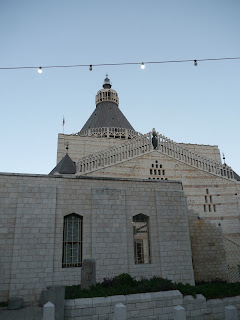
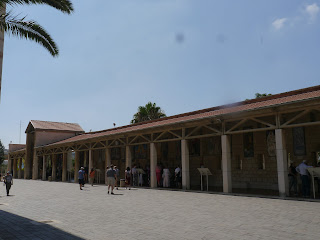
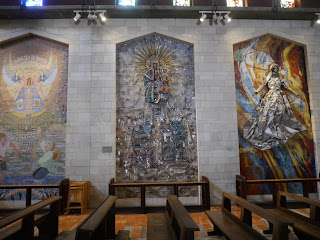






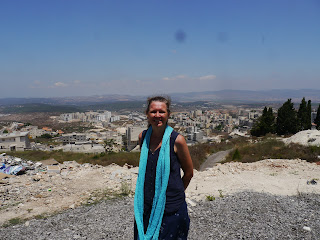









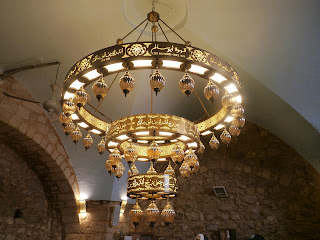

No comments:
Post a Comment